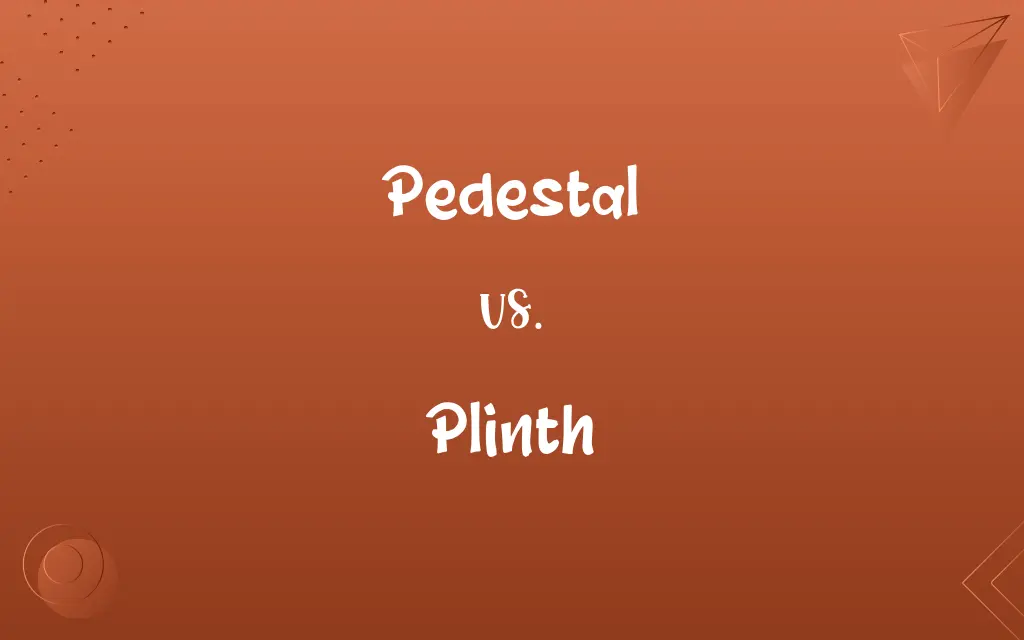Pedestal vs. Plinth: Know the Difference

By Dua Fatima & Shumaila Saeed || Updated on March 4, 2024
A pedestal is a base or support for a statue, vase, or column, often used to elevate art or furniture, whereas a plinth is a heavy base supporting a statue, column, or structure, focusing more on strength and stability.

Key Differences
Pedestals are designed to elevate and display art, sculptures, or decorative objects, enhancing their visibility and significance. They can be ornamental and vary in height, often adding to the aesthetic of the displayed item. On the other hand, plinths serve as the sturdy base for architectural elements, statues, or heavy objects, providing a solid foundation that emphasizes stability and support. Plinths are typically lower than pedestals and may be part of the structure they support, blending strength with aesthetic considerations.
Shumaila Saeed
Mar 04, 2024
While both pedestals and plinths are used to support and highlight objects or structures, pedestals are more associated with the idea of presentation and elevation in galleries, museums, or interior design. Conversely, plinths are fundamental in architecture and sculpture, acting as a transition between the ground and the object or structure, ensuring it is securely anchored.
Dua Fatima
Mar 04, 2024
Pedestals might be crafted from a variety of materials including wood, metal, or stone, and can feature intricate designs, reflecting the period or style of the object they support. Plinths, however, are often made from stone or concrete to bear significant weight, and their design is usually simpler, focusing on the object or structure's integration with its surroundings.
Dua Fatima
Mar 04, 2024
The use of pedestals extends beyond supporting art; they can also elevate furniture pieces like busts, plants, or lamps in home decor, adding a touch of elegance. Plinths, while sometimes used decoratively, are primarily functional components in construction, supporting and grounding architectural columns, buildings, or heavy statues in public spaces.
Shumaila Saeed
Mar 04, 2024
Pedestals and plinths both play crucial roles in displaying and supporting objects, but their applications, designs, and materials reflect their distinct purposes: pedestals for elevation and presentation, and plinths for strength and stability.
Dua Fatima
Mar 04, 2024
ADVERTISEMENT
Comparison Chart
Typical Use
Art, sculptures, decorative objects
Architectural elements, heavy statues
Dua Fatima
Mar 04, 2024
ADVERTISEMENT
Pedestal and Plinth Definitions
Pedestal
A support base for statues or decorative objects.
The ancient vase was displayed on a marble pedestal.
Dua Fatima
Mar 04, 2024
Plinth
Used in architecture and public spaces.
The plinths in the square supported an array of historical sculptures.
Dua Fatima
Mar 04, 2024
ADVERTISEMENT
Pedestal
Elevates art for better visibility.
The sculpture stood on a pedestal, drawing all eyes to its detail.
Shumaila Saeed
Mar 04, 2024
Plinth
Focuses on integration with surroundings.
The plinth was designed to blend the statue with the landscape.
Dua Fatima
Mar 04, 2024
Pedestal
Matches the style of supported objects.
The wooden pedestal was chosen to complement the bronze statue.
Dua Fatima
Mar 04, 2024
Plinth
Made of stone or concrete.
The plinth, crafted from concrete, bore the weight of the statue effortlessly.
Dua Fatima
Mar 04, 2024
Pedestal
Can be ornamental and stylish.
The intricately carved pedestal added elegance to the foyer.
Hifza Nasir
Mar 04, 2024
Plinth
Supports architectural structures.
Each column was mounted on a solid plinth for stability.
Shumaila Saeed
Mar 04, 2024
Pedestal
Used in galleries and homes.
Artists place their work on pedestals for an enhanced viewing experience.
Shumaila Saeed
Mar 04, 2024
Plinth
A heavy base for support and stability.
The monument was secured on a granite plinth.
Shumaila Saeed
Mar 04, 2024
Plinth
The base block at the intersection of the baseboard and the vertical trim around an opening.
Dua Fatima
Oct 19, 2023
Plinth
A continuous course of stones supporting a wall. Also called plinth course.
Dua Fatima
Oct 19, 2023
Plinth
A block or slab upon which a column, pedestal, statue or other structure is based.
Dua Fatima
Oct 19, 2023
Pedestal
A short free-standing column or column-like object designed to support a work of art or other object; a column serving the same function as the base of a statue. It may be made of wood, marble, or other suitable material.
Dua Fatima
Oct 19, 2023
Pedestal
A part of a desk which contains a frame and drawers, stands on the floor, and provides support for the desk surface. There may be zero, one, or two such pedestals in a desk.
Dua Fatima
Oct 19, 2023
Pedestal
A casting secured to the frame of a truck and forming a jaw for holding a journal box.
Dua Fatima
Oct 19, 2023
Plinth
In classical architecture, a vertically faced member immediately below the circular base of a column; also, the lowest member of a pedestal; hence, in general, the lowest member of a base; a sub-base; a block upon which the moldings of an architrave or trim are stopped at the bottom. See Illust. of Column.
Dua Fatima
Oct 19, 2023
Repeatedly Asked Queries
What is the main function of a pedestal?
The main function of a pedestal is to elevate and display art, sculptures, or decorative objects, enhancing their visibility and aesthetic appeal.
Shumaila Saeed
Mar 04, 2024
How does a plinth contribute to architectural design?
A plinth contributes to architectural design by providing a solid foundation for structures, ensuring stability, and facilitating the transition between the ground and the structure.
Dua Fatima
Mar 04, 2024
Are plinths always made of stone?
While stone is a common material for plinths due to its strength, plinths can also be made of concrete or other durable materials suited for bearing weight.
Dua Fatima
Mar 04, 2024
Do pedestals come in different styles?
Yes, pedestals come in various styles and materials, often designed to match or complement the style of the object they support.
Shumaila Saeed
Mar 04, 2024
Can pedestals be used outside of art display?
Yes, pedestals can also elevate furniture pieces like plants or lamps in home decor, adding a decorative touch.
Dua Fatima
Mar 04, 2024
Is it common to use plinths in interior design?
While less common than pedestals, plinths can be used in interior design, especially when a heavy or substantial look is desired or when integrating architectural elements.
Dua Fatima
Mar 04, 2024
What considerations should be taken into account when selecting a plinth for outdoor sculptures?
When selecting a plinth for outdoor sculptures, consider durability against weather conditions, the weight of the sculpture, and how the plinth integrates with the surrounding landscape.
Dua Fatima
Mar 04, 2024
Can a plinth be part of the object it supports?
Yes, in many cases, especially in architecture and sculpture, the plinth can be an integral part of the object or structure, designed to seamlessly transition from the base to the object.
Hifza Nasir
Mar 04, 2024
How do materials affect the choice between a pedestal and a plinth?
Materials play a significant role in the choice; lighter materials like wood or metal might be used for pedestals, while heavier, more durable materials like stone or concrete are preferred for plinths.
Shumaila Saeed
Mar 04, 2024
How do you choose between a pedestal and a plinth for displaying an object?
The choice between a pedestal and a plinth depends on the object's weight, the desired aesthetic, and whether the focus is on elevation/presentation (pedestal) or stability/support (plinth).
Dua Fatima
Mar 04, 2024
How does the height of a pedestal or plinth affect the displayed object?
The height of a pedestal or plinth can significantly affect how an object is viewed and perceived, with higher pedestals enhancing visibility and presence, while lower plinths provide a stable, grounded appearance.
Dua Fatima
Mar 04, 2024
Can the design of a pedestal affect the perception of the art it supports?
Yes, the design of a pedestal can influence the perception of the art, with the pedestal's style, height, and material either complementing or distracting from the art itself.
Shumaila Saeed
Mar 04, 2024
Are there any specific rules for matching pedestals to art pieces?
While there are no strict rules, it's generally best to choose pedestals that complement the art piece in style, size, and color, without overshadowing the art itself.
Shumaila Saeed
Mar 04, 2024
Share this page
Link for your blog / website
HTML
Link to share via messenger
About Author
Written by
Dua FatimaCo-written by
Shumaila SaeedShumaila Saeed, an expert content creator with 6 years of experience, specializes in distilling complex topics into easily digestible comparisons, shining a light on the nuances that both inform and educate readers with clarity and accuracy.








































































